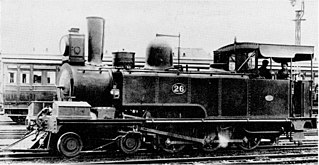
Under the Whyte notation for the classification of steam locomotives, 0-4-0 represents one of the simplest possible types, that with two axles and four coupled wheels, all of which are driven. The wheels on the earliest four-coupled locomotives were connected by a single gear wheel, but from 1825 the wheels were usually connected with coupling rods to form a single driven set.

The South African Railways Class A 4-8-2T of 1888 is a steam locomotive class from the pre-Union era in the Colony of Natal.

The South African Railways Class H2 4-8-2T of 1909 was a steam locomotive from the pre-Union era in the Colony of Natal.
The South African Railways Class 2C 4-6-2 of 1910 was a steam locomotive from the pre-Union era in the Colony of Natal.

The South African Railways Class C 4-6-0T of 1879 was a steam locomotive from the pre-Union era in the Colony of Natal.

The South African Railways Class C1 4-6-2T of 1901 was a steam locomotive from the pre-Union era in the Natal Colony.

The South African Railways Class C2 4-6-4T of 1896 was a steam locomotive from the pre-Union era in the Colony of Natal.

The South African Railways Class G 4-8-2T of 1904 was a steam locomotive from the pre-Union era in the Colony of Natal.

The Natal Government Railways Class K 2-6-0T of 1877 was a South African steam locomotive from the pre-Union era in the Natal Colony.

The Natal Government Railways Class K 0-6-0ST of 1880 was a South African steam locomotive from the pre-Union era in the Colony of Natal.

The Natal Government Railways Class K 0-4-0ST of 1891 was a South African steam locomotive from the pre-Union era in the Colony of Natal.

Durban Harbour's Edward Innes of 1901 was a South African steam locomotive from the pre-Union era in the Colony of Natal.

Durban Harbour's Congella of 1902 was a South African steam locomotive from the pre-Union era in the Colony of Natal.

Durban Harbour's Sir Albert of 1904 was a South African steam locomotive from the pre-Union era in the Natal Colony.

The Cape Government Railways 1st Class 2-6-0ST of 1876 was a South African steam locomotive from the pre-Union era in the Cape of Good Hope.

The Cape Government Railways 2-6-0ST of 1900 was a South African steam locomotive from the pre-Union era in the Cape of Good Hope.

The Port Elizabeth Harbour 0-4-0ST of 1894 was a South African steam locomotive from the pre-Union era in the Cape of Good Hope.

The Cape Government Railways 2-6-0ST of 1902 was a South African steam locomotive from the pre-Union era in the Cape of Good Hope.

The Cape Government Railways 0-4-0ST of 1881 was a South African steam locomotive from the pre-Union era in the Cape of Good Hope.

The Natal Government Railways Class K locomotives include three locomotive types, all designated Class K irrespective of differences in wheel arrangement.



















